- What is the main function of a fuel cell filter?
- What type of substances are filtered to protect the fuel cell?
- Why are fuel cell filters so important for fuel cell systems?
- What types of fuel cell filter exist?
- What are the key performance criteria of a fuel cell filter?
- What are the different types of filter element available?
- Why is the pressure drop so important on a fuel cell filter?
- Where exactly are fuel cell filters placed in fuel cells or hydrogen systems?
- What are the effects of clean air in a fuel cell stack?
- How often do filters need to be replaced?
Browse fuel cell filters from leading suppliers on our marketplace!
What is the main function of a fuel cell filter?
PEM fuel cell technology can play a significant role in the decarbonization of transportation, power generation and off-road application. To achieve market penetration, customer expectations with regard to durability, but also cost must be satisfied. One of the factors leading to fuel cell stack degradation is the effect of harmful airborne contamination, e.g. particles, NOx, SO2 and NH3. In order to implement the requirements for the long-term durability of fuel cell systems, they must be protected by cathode air cleaners. Efficient and high-performance cathode air filters help to achieve these targets.
What type of substances are filtered to protect the fuel cell?
The function of the cathode air path of a fuel cell is to provide air at the correct temperature, pressure, degree of humidity and cleanliness. In order to ensure effective protection, in-depth knowledge about contaminants and degradation mechanisms is required. Modern fuel cell filters address the following substances:
- Particles in cathode air entering the fuel cell stack can lead to blocking of the Gas Diffusion Layer (GDL), the Micro Porous Layer (MPL) and other flow channels which leads to reduced media transport and thus a loss in performance. Salt particles also act on membranes by reducing their ion conductivity.
- Harmful gases can degrade stack performance in two ways: The first is catalyst poisoning. In this case, harmful gases occupy active sites on the platinum catalyst, thus reducing the Electrochemical Active Surface Area (ECSA) depending on the type and concentration. This results in a temporary or permanent drop in stack voltage and therefore a decline in the performance of the fuel cell. The second is that harmful gases such as ammonia (NH3) have an effect on the durability of the membranes in the fuel cell stack and humidifier. Chemical reaction with the membrane´s sulfonic acid functionalities can lead to increased ohmic resistance and a reduction in water and proton transfer performance. In addition, accelerated ageing and degradation effects also lead to the deterioration of mechanical properties.
Why are fuel cell filters so important for fuel cell systems?
The effects of harmful gases on the performance of fuel cells especially after prolonged exposure are often irreversible, therefore effective protection of the components is essential. Tests of the effect of NOx on the performance of a fuel cell with a supply of unfiltered ambient air indicated that prolonged exposure resulted in a constantly lower cell voltage and therefore lower performance. In addition, peaks of NOx present in the atmosphere resulted in substantially lower performance for a temporary period. High traffic volumes can lead to higher NOx concentrations and, due to faulty operation settings in Selective Catalytic Reduction (SCR) technology, to higher NH3 emissions – these are also encountered in farming areas.
The efforts of manufacturers to reduce stack costs by lower platinum loading and reducing membrane thicknesses or surfaces lead to increased requirements with regard to protection against harmful gases.
What types of fuel cell filter exist?
Typically, the filter taxonomy relates to the type of filtering media used:
- Synthetic media: To remove particles from cathode air, synthetic filter media are used.
- Carbon: Functionalized activated carbon is used to remove harmful gases from the air by adsorption.
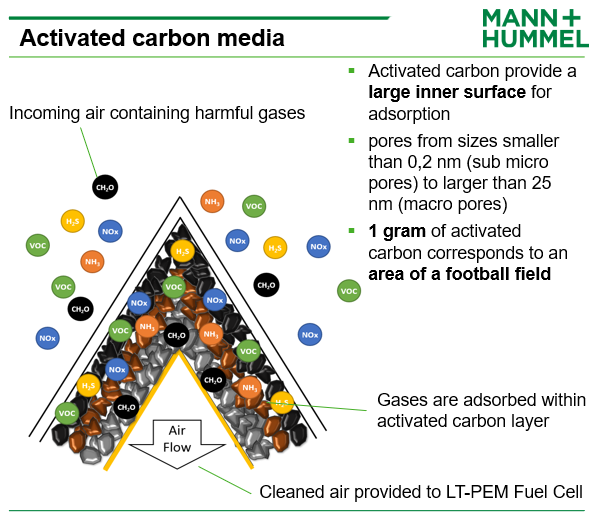
- Chemisorption: To capture the polar target gases, chemisorption must be applied.
- Chemisorption process: Impregnating activated carbons with acids that bind basic gases, e.g., NH3. Activated carbon functionalization exposes polar chemical groups of opposite polarity.
In most cases, combined filter elements with both particle filter and gas adsorption layers are applied. Special care must be taken if the fuel cell will be operated in dusty environments.
What are the key performance criteria of a fuel cell filter?
The main key performance parameters for fuel cell filters are:
- Gas adsorption efficiency – the gas adsorption efficiency of fuel cell filters describes how well a filter can adsorb specific target gases and varies with the type of gas and its concentration.
- Gas adsorption capacity – the gas adsorption capacities of a fuel cell filter rate how much of a gas can be adsorbed and varies on the gas and its concentration.
- Particle filtration efficiency – describes how well different particle sizes can be captured by fuel cell filters.
- Pressure drop.
Gas adsorption performance is measured according to ISO 11 155-2 and depends on upstream gas concentration which is much higher than real-life concentrations to achieve acceptable test durations, e.g., 80 ppm for toluene, and 30 ppm for NOx and SO2.
Adsorption efficiency strongly depends on how much the adsorber is already loaded, and the best filters have efficiencies well beyond 90%. Adsorption capacity is determined at 95% breakthrough or a defined test duration, e.g., 3 hours of loading. The actual filter capacity depends on activated carbon mass – cylindrical filters for 80 – 130 kW fuel cells reach more than 100 g of toluene at 80 ppm loading and 95% efficiency, more than 30 g of SO2 at 30 ppm loading after 3 hours, and more than 25 g of NOx under the same loading conditions.
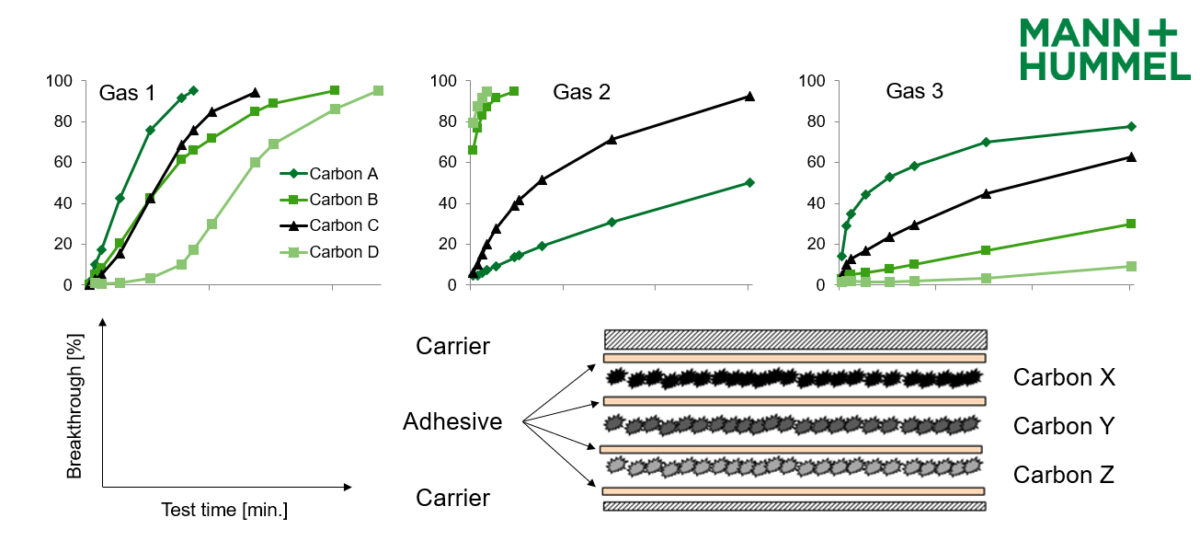
The figure above shows the principle of functionalized activated carbons. The breakthrough curves of different activated carbons for different gases are compared. While activated carbon A reaches its saturation point for gas 1 after a short time, it is very effective for gas 2. On the other hand, activated carbon D is not suitable for gas 2, but works best for gas 3. The combination of different activated carbon layers can therefore maximize the adsorption efficiency for special exposure characteristics. In all cathode air filters, the optimum balance between volumetric adsorption efficiency and pressure drop must be found, defining the design of the cathode air filter element. If the harmful gas passes several layers of activated carbon, the probability for adsorption increases while the pressure drops increase well.
ISO 5011 is applied to rate the particle filtration performance of fuel cell filters. When loaded with A2 Test Dust (ISO 12 103 – 1g/m³). The filter described above reaches initial filtration efficiencies of 99% and above, with a dust capacity of 150g at 50 mbar pressure drop.
As you can see from the illustration below, the different filter media are used in combination.

What are the different types of filter element available?
There are generally 3 different types of filter elements available.
a) Pleated filter element
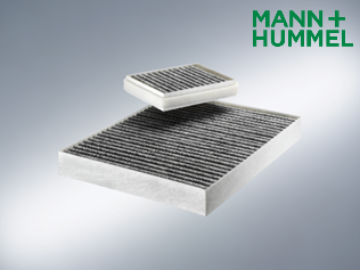
b) Stack filter element and
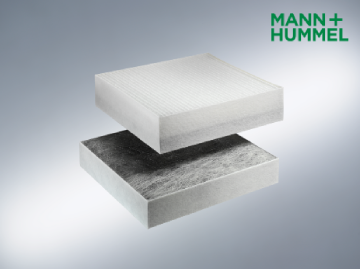
c) Round filter element
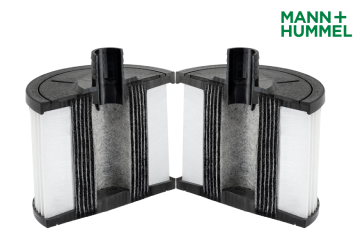
The performance of these elements respective to each other can be found in the volume flow vs. pressure loss curves below. It is also important to note that if the volume flow is decreasing then the adsorption efficiency will increase.
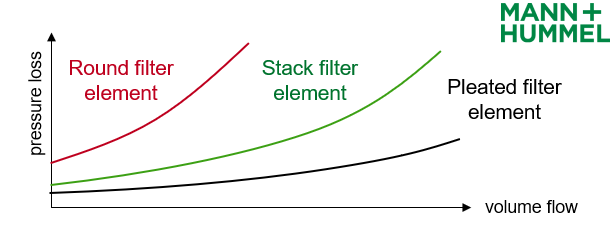
Why is the pressure drop so important on a fuel cell filter?
Higher pressure drop must be compensated by higher compressor performance which creates additional noise but also consumes more energy, thus reducing the overall fuel cell system efficiency. One countermeasure is to increase the filter´s size, but this is not possible in all applications. For example, in passenger cars, fuel cell stacks require high air flows, but only a small volume is available – therefore, panel air filter designs are often used. In commercial vehicles, more space is available – and in combination with the higher lifetime requirements, cylindrical elements with several activated carbon layers are favored. If the airflow is low, e.g., with smaller fuel cell stacks, cylindrical elements are preferred.
Where exactly are fuel cell filters placed in fuel cells or hydrogen systems?
Cathode air filters are placed upstream of the compressor, also to protect these components from particulate contamination. If there´s a risk of water ingress, a water separator should be placed upstream of the filter element as liquid water on the filter element could block the passage of air and occupy adsorption sites in the adsorber layers.
The following illustration shows an exemplary layout.
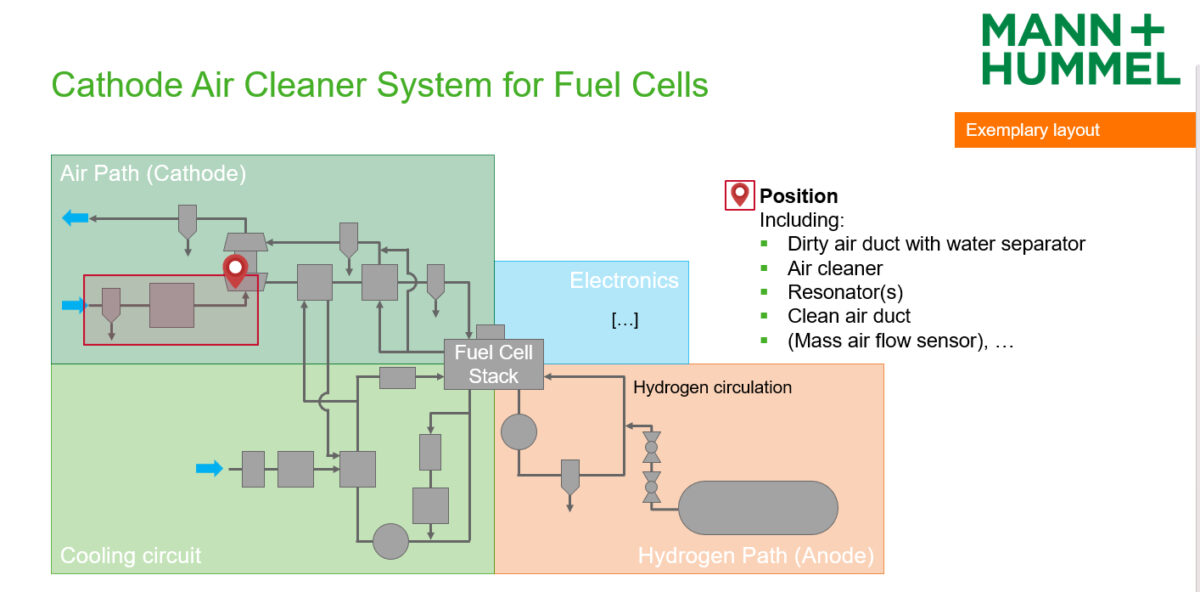
As evident above, the fuel cell filter is placed upstream of the compressor.
What are the effects of clean air in a fuel cell stack?
Fuel cell filters clean the air which ultimately improves the performance of a fuel cell system. The figure below is a result of a ZBT test done to analyze the effect of clean air on a fuel cell stack.
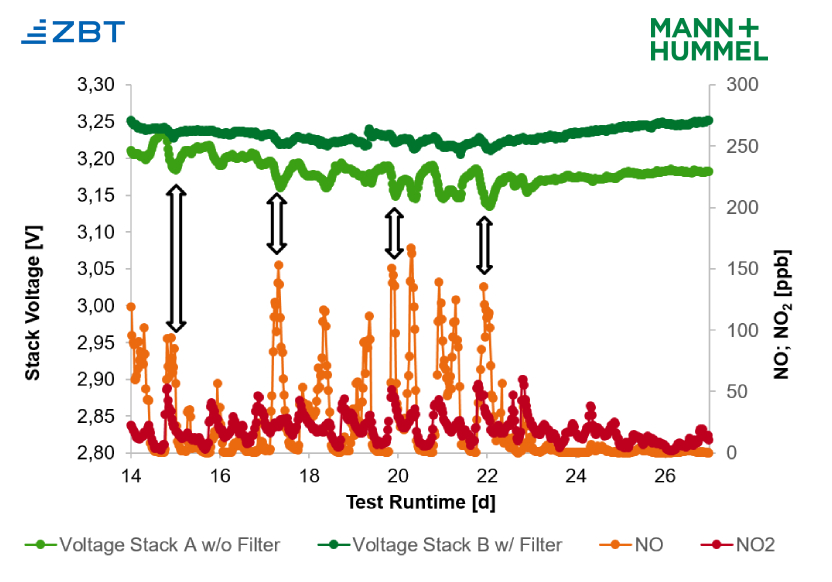
As can be observed from the figure above, the voltage of stack A operated with a filter remains almost constant, while stack B suffers more degradation, caused by NOx as shown by voltage drop as a consequence of peaks in NOx concentration. This clearly shows that clean air plays an important role in improving the performance of a fuel cell system.
How often do filters need to be replaced?
As the gas adsorption capacity for target gases in cathode air filter elements depends on adsorber mass, the filter must be changed when the activated carbons are fully loaded, or the harmful gas starts to break through. So, the service interval very much depends on activated carbon mixture, adsorber mass and filter size. To achieve appropriate filter lifetimes, the typical target gas concentrations to be encountered in typical operating conditions should be known, enabling a filter design with well-balanced adsorption performance.
Content contributed by MANN+HUMMEL
MANN+HUMMEL is a leading global company in filtration technology. Under its two business units Transportation and Life Sciences & Environment, the Ludwigsburg-based Group develops intelligent solutions that enable cleaner mobility, cleaner air and cleaner water. Thus, the company makes an important contribution to a clean earth and the sustainable use of limited resources. In 2020, over 23,000 employees at more than 80 locations generated a turnover of EUR 4.2 billion. We are your perfect partner to develop and globally scale your fuel cell business as we can leverage more than 80 years of know-how in filtration.
Last update: 15.1.2023












